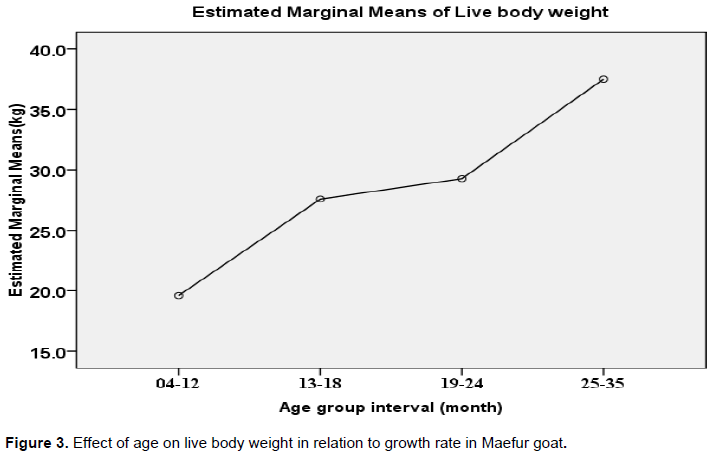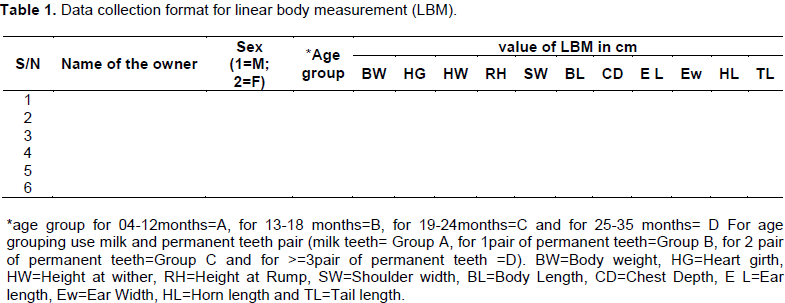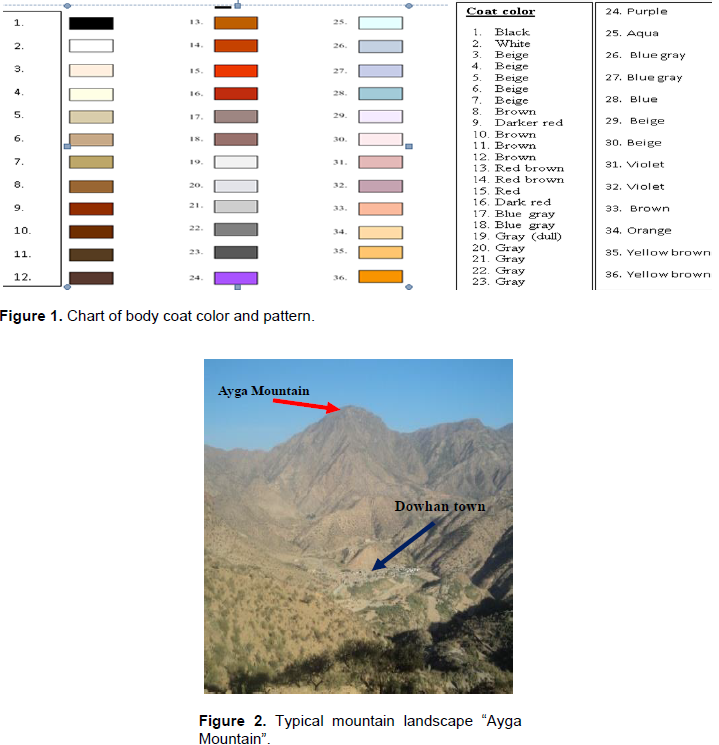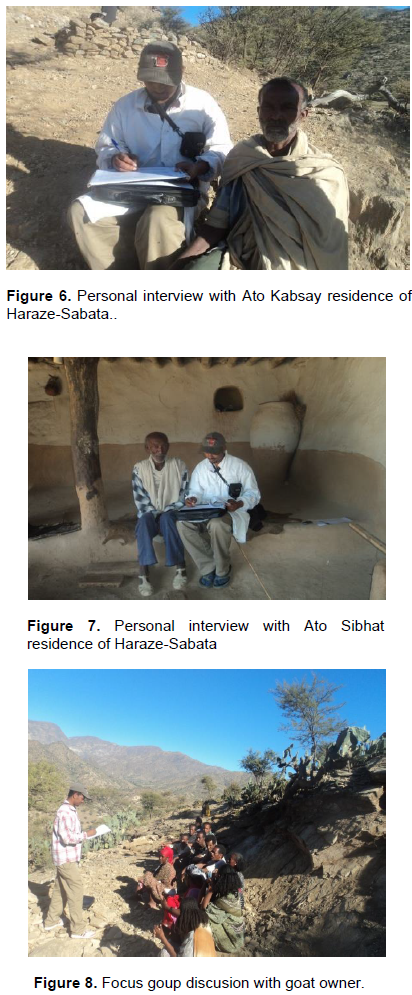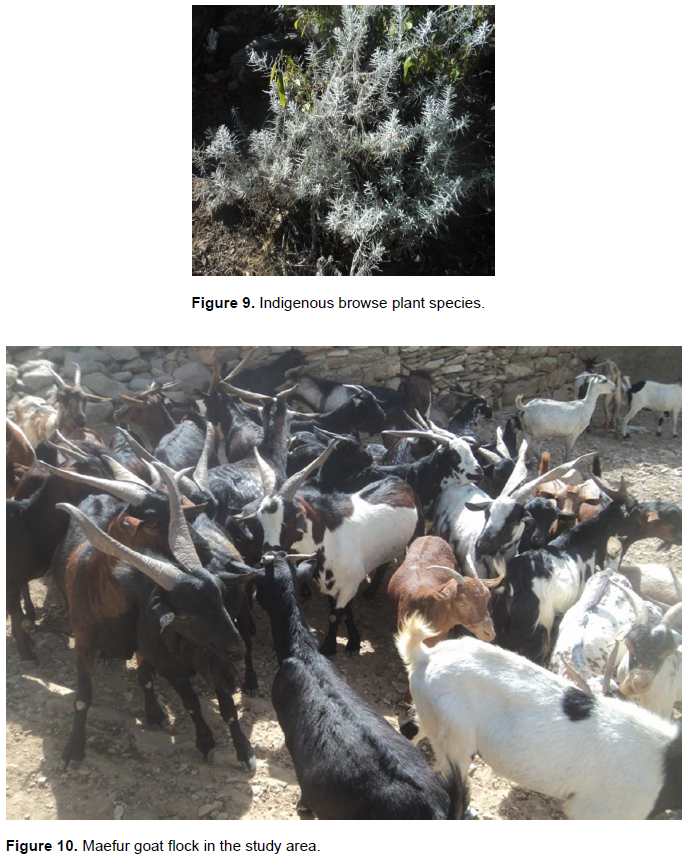The study was conducted in Erob district eastern Tigray, Ethiopia to phenotypic characterize Maefur goat based on physical body feature and linear body measurements. Six hundred (297 male and 303 female) goats were randomly selected and grouped into four age groups of 0, 1, 2 and ≥3 PPI. General Linear Model (GLM) procedure of SPSS version 16.0 and descriptive statistical analysis were were used to summarize the collected data. Short ear size (12.3 cm for male and 11.8 cm for female), long and thick horn, medium body size (42.8 kg for male and 32.7 kg for female), and large heart girth (82.1 cm for male and 73.4 cm for female) are the major body characteristics of Maefur goat breed. There was a significant (P< 0.05) effect of sex and age on live body weight and linear measurements. Mean± SE of live body weight, heart girth, body length and height at wither in male were 34.7±0.57 kg, 75.3±0.53 cm, 64.3±0.61 cm and 64.7±0.46 cm, respectively while in female 28.9±0.35 kg, 70.0±0.33 cm, 60.0±0.40 cm, and 59.3±0.31 cm, respectively. For heart girth in these age groups were 61.1±0.53, 69.4±0.33, 70.6±0.4 and 77.7±0.39 cm, respectively while body length were 50.3±0.43, 56.8±0.42, 59.3±0.58 and 68.2±0.42 cm, respectively. For height at wither in these age groups were 54.0±0.45, 59.1±0.35, 58.4±0.32 and 66.5±0.40 cm, respectively. Heart girth and height at wither were significantly (P<0.05) different among the age groups except between 13-18 and 19-24 months. The study revealed that large heart girth is a unique characteristic of the Maefur indigenous goat. The study concluded that Maefur goat breed is identified as one of the potential goat breed in Tigray, Ethiopia.
Description of the study area
The study was conducted in Erob district found 47 km northeast of Adigrat in the eastern zone Tigray. It is located at 14010’ to 140 25’N and 390 40’ to 390 50’E (Tesfay et al., 2011). The max and min annual temperature ranges from 25 to 30°C and 12 to 16°C, respectively. Mean annual rainfall ranges from 250 to 300 mm during the rainy months of June and August (EAZT, 2005). The study area covers an altitude ranging between 1200 and 3000 m above sea level (Tesfay et al., 2011). It has also notable topographic features including the “Ayga” (Appendix Figure 2) and “Assimba” mountains (Appendix Figure 3).
Sampling procedure
Purposive sampling of the district and potential PA was used because of the existence of the potential indigenous goat population named as Maefur DAGRIS (2004) and the information about their distribution in the regional government of Tigray is already reported by Tigray Agricultural Research Institute but no one tried to reach them for phenotypic characterization. About 600 randomly selected indigenous goats of 49.5% male and 50.5% female goats were used during phenotypic characterization. The variables measured included live weight recorded using Salter scale with capacity of 50 kg (accuracy nearest 200 g) and linear body measurements using meter tape (1.5 meter and accuracy 0.5 cm). Age of the sampled animals was determined using dentition as recommended by Solomon (2009) and Wilson and Durkin (1984). The selected animals were grouped into one of the following age categories: 0 PPI (04 to12 month with 46 male and 36 female, 1 PPI (13 to 18 months) with 47 male and 40 female, 2 PPI (19 to 24 months) 57 male and 77 female, and ≥3 PPI (25 to 36 months and above) with 147 male and 150 female. Linear body measurements recorded for each study animal were heart girth, height at withers, height at rump, shoulder width, chest depth, body length, ear length, ear width, horn length, head width and head length.
Procedures of recording body measurements
The coat color (using color chart) and pattern, shape and orientation of the horns and ears, size of tail, and profile of head, back and rump can be recorded using coded descriptors (FAO, 2012). Descriptive information should be recorded on the common flock sizes and structures as well as uses.
Recording LBM
Linear body measurements (LBM) were recorded in the morning before the animals are fed, with the animals standing on a flat surface with head held up (Appendix Table 1). Hanging spring scale was used to measure body weight (BW) to the nearest 0.1 kg. Heart girth (HG) was measured by taking the circumference of the chest using a tailor’s tape calibrated in cm, taken as the circumference of the body immediately behind the shoulder blades in a vertical plane, perpendicular to the long axis of the body. Height at wither (HW) was measured as the distance from the ground to the withers. Height at rump (HR) is measured as the distance from the ground to the rump. Shoulder width (SW) was measured as a distance between the shoulders. Chest depth (CD) was measured as the distance between the top behind the scapular and the flow of the sternum (taken to be the depth of brisket) immediately behind forelegs. Body length was the distance from the head of humerus to the distal end of the pubic bone.
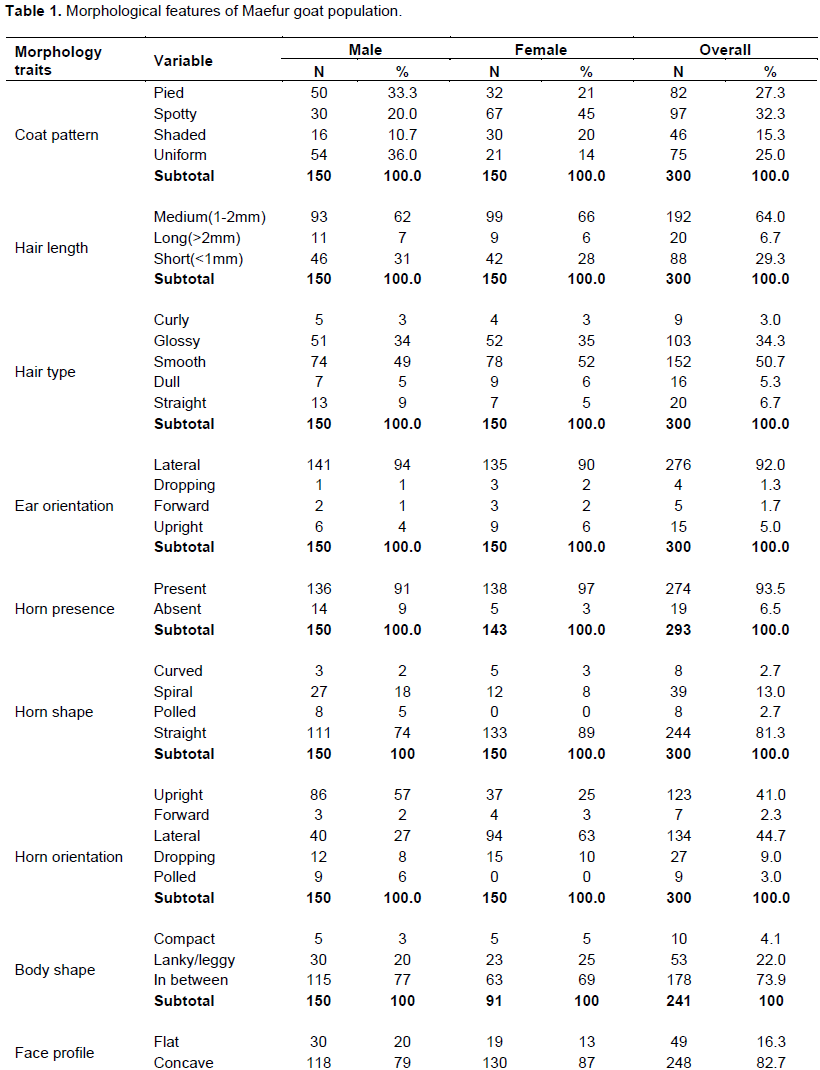

Statistical data analysis
Different analysis methods were applied using SPSS version 16.0 software program. Live body weight and linear body measurements were subjected to List-square analysis of variance using the General Linear Model (GLM) procedure of SPSS version 16.0 with sex and age as fixed effects. The Tukey's simultaneous test was used to separate significance of least-square means. Physical body traits were analyzed using descriptive analysis for mean and standard deviation (quantitative data) and frequency (qualitative) of the variables.
Yij = µ + Si + Aj +Lij + Eij -------------------------------------------- Model 1 (General Linear Model, GLM)
Where:Yij = the observation of the ith animal within the jth age of ith sex; µ = overall mean; Si = effect of the ith sex (male and female); Aj = effect of jth age (04-12, 13-18, 19-24, and 25-35 months and above); Lij = interaction effect of the ith sex and jth age groups, and Eij = Random error factor.
The effect of sex, age and their interaction on live body weight and linear body measurements were determined at 5% level of significance. Least-squares means for sex and age groups were separated using Student's t-test and Duncan’s Multiple Range Test (DMRT), respectively. The difference between and among the least squares means was determined at 5% level of significance. Indices were calculated in the excel Microsoft to provide ranking of the observed body and head color.
Index = Sum of [4 for tick + 3 for rank 1 + 2 for rank 2+1for rank3] for each color divided by sum of [4 for tick + 3 for rank 1 + 2 for rank 2+1for rank3] for each colora
Physical body characteristic of the indigenous Maefur goat population
The study observed variety of coat pattern in Maefur goat population. The overall coat color pattern of the sampled goat was described as spotty (32.3%), pied 27%, uniform (25%) and shaded (light brown, black, and gray) (15.3%) (Table 1). Medium (1-2 mm) (64%) and short (29.3%) hair length were the overall description of the indigenous Maefur goat population. Short, narrow, thin, and laterally oriented ear (92% of incidence) was the overall characteristic of Maefur indigenous goat breed. This observation of the current study revealed that Maefur goat has dominant lateral ear orientation distinguished from Begait goat with dropped ear orientation. Solomon (2009) stated that ear orientation and size are important for discrimination of more related indigenous goat breeds. The overall descriptions for horn orientation of the observed indigenous Maefur goat breed were backward (45%) and upright (41%), respectively with frequently observed straight (81%) and spiral (18%) horn shapes. The overall body shape characteristics of the sampled Maefur goat breed was in-between with 76% and lanky with 20% (Figure 1). The dominant body shapes (in- between leggy and compacted) had some implication to distinguish Maefur indigenous goat from 12 indigenous goat breed of Ethiopia documented by DAGRIS (2004) and Kassahun and Solomon (2008). Concave (83%) and flat (straight 16%) facial profiles were the most descriptor for the overall facial profile of Maefur goat breed.

Body color of the indigenous Maefur goat was assessed using randomly selected 750 goats 5 goats from each 150 household (Appendix Figure 1). The most frequently observed body coat color was beige, black and brown with an index value of 0.30, 0.20 and 0.18 (Table 2). Figure 2 illustrates the variety of morphological characteristics of Maefur goat flock. The smooth hair type with spotty coat color, long horn (straight and spiral) and sometimes polled in male), short ear size, straight facial profile and potential for meat improvement are the most important physical characteristics of the indigenous goat population. It has its own distinguishing feature and local name apart from the afar goat. Afar goats are characterized as small breed in Ethiopia (Solomon, 2009). The afar goats are recognized with local name of Adal in Afar region and widar (dwarf) in the border area of Tigray brought to be sold in Mekelle city for meat purpose. Maefur and Afar goat populations are distinct in phenotypic performance (Maefur has larger body size than afar goat) but they have some similarities in the coat color patterns (Figure 2 and Appendix Figure10).

Body weight and linear body measurement in Maefur goat
Table 3 summarized the least squares means for live body weight and body measurement in different age groups and sex for the Maefur goat breed. The main source of variation on live body weight and linear body measurement were sex, age and the interaction of both sex and age.
Effect of age, sex and their interaction on body weight and linear body measurements
There was a significant (P < 0.001) variation for live body weight, heart girth, height wither, height at rump, shoulder width, body length, chest depth, horn length, tail length, head width and head length among the four age groups (04-12, 13-18, 19-24 and 25-35 months) but no significant (P>0.05) variation for ear length and ear width among these age groups. The variation for live body weight, heart girth, height withers, height at rump, shoulder width, body length, and chest depth was also significant (P < 0.001) between male and female but no significant (P>0.05) variation for horn length, tail length, ear length, ear width, head width and head length for interaction of sex and age group. The report of this finding is in line to the findings reported by Khan et al. (2006) and Fajemilehin and Salako (2008) and Alemayehu et al. (2012).
Live body weight and linear body measurements
Live body weight
The average live body weight of Maefur male goat in four age groups (04-12,13-18,19-24 and 25-35 months) was 20.5±3.3, 28.6±3.1, 31.2±4.1 and 42.8± 6.6 kg, respectively while that of female in the same age groups were noted as 18.5±4.4, 26.4±2.9, 27.9±4.59, and 32.7±4.1 kg, respectively (Table 4). Significant (P<0.05) difference was found in live body weight between male and female goat in all age groups. This finding of the current study is agreed with the report of Khan et al. (2006) and Alemayehu et al. (2012). The average live body weight of Maefur goat was 42.8 and 32.7 kg for adult male and female goat, respectively. For pooled sex of the adult Maefur goat, the average live body weight was 37.7 kg. For the indigenous goat breed of Ethiopia, the average live body weight for Gumuz, Agew goats, Begia-Medir goats, Bati goat, Abergelle goats, and Central Abergelle goats was 34.6, 31.5, 32.5, 29.9 and 28.1, 27.9 kg, respectively (Hassen et al., 2012). According the east Africa goat size classification method, body size of the goat breed is categorized in to three groups: Small (20-30 kg), medium (30-45 kg) and large (45-60 kg) (Kiwuwa, 1992).

Accordingly, Maefur goat is classified as medium sized indigenous goat. Saanen goat is a large goat breed with average live body weight of 65 kg for male and 50 kg for female (Pesmen and Yardimci, 2008). Therefore, live body weight is among the production trait used to classify goat population in to breed standard and are important in giving information about the morphological structure and development ability of the animal (Kiwuwa, 1992, Hassen et al., 2012; Riva et al., 2002). Ethiopian goats are classified according to the body weight and height at wither. Based on the average adult age (25-35 months), both male and female Maefur goats have medium body size.
Heart girth
The average heart girth of Maefur male goat in four age groups (04-12,13-18,19-24 and 25-35 months) were found to be 61.9±3.8, 69.9±3.2, 72.8±4.7 and 82.1±6.3 cm while that of female in these age groups were investigated to be 59.9±5.8, 68.7±2.7, 69.0±4.1 and 73.4± 3.2 cm, respectively. Significant (P<0.05) difference was reported in heart girth between male and female goat within age group 3 and 4. There was no significant (P>0.05) difference in heart girth between male and female in the age group of 1 and 2. The average heart girth 82.1 cm for male and 73.4 cm for female adult Maefur goat breed was higher than that of Abergelle reported as 68.67 and 64.44 cm for adult male and female, respectively (Alemayehu et al., 2012). Body size of the adult goat is the indication of heart girth, body length, height at wither and height at rump. Among these major linear body measurement heart girth is widely used to classify physical characteristic of Ethiopian goat families and breeds (Solomon, 2009). Adult female Maefur goat with an average value of heart girth 73.4 cm had comparable size with Western Highland goats with 75.8 cm classified as large whereas Afar goat with average heart girth 67.4 cm are classified as small indigenous goat in Ethiopia (Solomon, 2009).
Height at wither
The average height at wither of Maefur male goat in four age groups (04-12, 13-18, 19-24 and 25-35 months) were determined as 55.5±3.9, 59.4±2.8, 60.9±3.1, and 70.8±6.1 cm while that of female in these age groups were recorded to be 52.2 ± 3.7, 58.7± 3.8, 56.6±3.1 and 62.3±4.6 cm, respectively (Table 4). Significant (P<0.05) difference was reported in height at wither between male and female goat within age group 3 and 4. There was no significant (P>0.05) difference in height at wither between male and female between age group of 1and 2. The stage of growth and development might musk the difference between male and female at early age. The adult female (25-35 months) Maefur goat breed with 62.3 cm height at wither is in between the Afar and Western Highland goat breed as 60.9 and 70.8 cm, respectively (Solomon, 2009). Both male and female adult Maefur goat with average height at wither 70.8 and 62.3 cm, respectively are larger than the Abergelle goat reported as 61.05 and 59.44 cm, respectively for adult male and female (Alemayehu et al., 2012). According to the classification criteria using height at wither and body weight for body size of Ethiopia indigenous goat suggested by Kassahun and Solomon (2008), there are three classes: large, >65 cm and weighing 37-50 kg; small, 51-65 cm and weighing 26-36 kg; dwarf, <50 cm and weighing 18-25 kg). Therefore, both male and female Maefur indigenous goats are classified as large body size.
Heights at rump
The average heights at rump of the Maefur male goat in four age groups (04-12, 13-18, 19-24, and 25-35 months) were determined as 56.8±4.7, 61.8±4.1, 62.2±4.2 and 67.6±4.5 cm, respectively whereas in female were noted to be 56.2±4.9, 61.2±4.3, 58.5±5.1 and 61.5±3.9 cm, respectively. Significant (P<0.05) difference was reported in height at rump between male and female goat within age group 3 and 4. There was no significant (P>0.05) difference between male and female in age group of 1and 2.
Shoulder width
The average shoulder width of the Maefur male goat in four age groups (04-12, 13-18, 19-24 and 25-35 months) were recorded to be 10.1±1.7, 9.7±3.1, 11.6±1.5, 12.1±1.4 cm while in female in these age groups were 8.5±2.3, 10.8±2.0, 10.3±2.0 and 10.4±1.5 cm, respectively. Significant (P<0.05) difference was reported in shoulder width between male and female goat within age groups 1, 3, and 4. There was no significant (P>0.05) difference between male and female in age group 2.
Body length
The average body length of Maefur male goat in four age groups (04-12, 13-18, 19-24, and 25-35 months) were recorded to be 51.0±4.1, 56.2±4.0, 61.8±6.8, and 72.3±7.1 cm while in female in these age groups were 49.4±3.6, 57.5±3.7, 57.6±6.4, and 64.3±5.0 cm, respectively. Significant (P<0.05) difference was reported in body length between male and female goat within age group 3 and 4. There was no significant (P>0.05) difference between male and female in the age group of 1 and 2. Both male and female adult Maefur goat with average body length 72.3 and 64.3 cm, respectively are larger than the Abergelle goat reported as 53.00 and 52.03 cm, respectively for adult male and female (Alemayehu et al., 2012). The faster growth of male goats than females at early stage is suggested because of the hormonal effect that is non-release of androgen (which is known to have growth and weight - stimulating effects) in male animals until the testis are well developed (Frandson and Elmer, 1981). Therefore, male goats are heavier and larger than female goat.
Chest depth
The average chest depth of Maefur male goat in four age groups (04-12, 13-18, 19-24, and 25-35 months) were recorded to be 7.0±2.3, 7.1±2.4, 11.9±2.6, and 10.4±2 cm, respectively whereas in female in these age group were 5.4±2.5, 7.4±2.7, 7.3±1.7, and 7.6±2.7 cm, respectively. Significant (P<0.05) difference was reported in chest depth between male and female goat within age group 1 and 4. There was no significant (P>0.05) difference chest depth between male and female in the age group of 2 and 3.
Ear length and ear width
The average ear length of Maefur male goat in four age groups (04-12, 13-18, 19-24 and 25-35 months) were determined to be 11.7±1.8, 11.6±2.5, 5.0±1.1 and 12.3±2.5 cm, respectively while in female in these age groups were 11.5±2.5, 11.1±2.3, 12.0±2.4 and 11.8±2.3 cm, respectively. The average ear width of Maefur male goat in four age groups (04-12, 13-18, 19-24 and 25-35 months) were determined to be 4.9±0.8, 5.2±1.1, 16.6±3.6 and 5.2±1.0 cm while in female in these age groups were 4.9±0.8, 4.9±0.7, 5.1±1.3 and 5.0± 0.1 cm, respectively (Table 5). There was no significant (P>0.05) difference in ear length between male and female in all age groups whereas ear width significantly (P<0.05) differed between male and female in age group 4 whereas it was not significantly (P> 0.05) differed in age group 1, 2, and 3. The indigenous Maefur goat is described as short and narrow ear.

Horn length
The average horn length of Maefur male goat in four age groups (04-12, 13-18, 19-24 and 25-35 months) were determined to be 11.4±3.5, 16.7±4.1, 13.3±2.1 and 19.3±6.3 cm while in female in these age groups were 9.9±5.0, 13.4±3.5, 15.0±4.3 and 15.6±4.2 cm, respectively. Significant (P<0.05) difference was reported in horn length between male and female goat within age group 2, 3 and 4 whereas there was not significantly (P> 0.05) differed in age group 1. Maefur indigenous goat has medium sized and thick horn with some times spiral shape pointed upward for male whereas for female, short, thick, straight, and backward oriented horn.
Tail length
The average tail length of Maefur male goat in four age groups (04-12, 13-18, 19-24 and 25-35 months) were determined to be 12.4±1.2, 13.7±2.2, 12.9±4.3 and 13.6±2.1 cm while in female in these age groups were 9.2±4.0, 12.3±3.5, 19.2±2.4 and 14.4±5.0 cm, respectively. There was no significant (P>0.05) difference in tail length between male and female in all age group.
Head width and length
The average head width of Maefur male goat in four age groups (04-12, 13-18, 19-24 and 25-35 months) were determined to be 9.2±4.0, 12.3±3.5, 9.4±3.9, 10.7±3.3 and 14.4±5.0 cm while in female in these age groups were 9.4±3.5, 9.4±3.9, 10.7±3.3 and 12.6±4.5 cm, respectively. The average head length of male in these age groups were 17.2±3.2, 19.0±3.3, 19.3±2.5 and 21.1±3.1 cm while for female in these age group were 14.0±4.2, 18.9±1.7, 18.2±2.5 and 19.9±2.5 cm, respectively. Significant (P<0.05) difference was reported in head length between male and female goat within age group 2, 3 and 4 whereas it was not significantly (P> 0.05) differed in age group 1. Significant (P<0.05) difference was reported in head width between male and female goat within age group 1, 3 and 4. It was not significantly (P> 0.05) differed in age group 2.
Effect of sex on body weight and linear body measurements
The LSM of body weight, heart girth, height wither, height at rump, shoulder width, body length, chest depth in male were 34.7±0.57 kg, 75.3±0.53 cm, 64.7±0.46 cm, 64.8±0.34 cm, 11.3±0.12 cm, 64.3±0.61 cm, and 8.7±0.18 cm, respectively (Table 5). The LSM for these measurements (same order) in females were 28.9±0.35 kg, 70.0±0.33 cm, 59.3±0.31 cm and 59.2±0.27 cm, 10.2±0.11 cm, 60.0±0.40 cm, and 7.2±0.15 cm, respectively. There was significant (P<0.05) difference between male and female LSM value of these measurements. Considering the LSM value of the live body weight and the major linear body measurement like heart girth, height at wither, body length and height at rump, the study revealed that male goat are heavier and larger than female goat at 95% level of confidence. This result of the current study is in line to the findings of Hassan and Ciroma (1990) in the Red Sokota goat breeds.
Effect of age on body weight and linear measurements
There was a significant (P<0.05) difference both in live body weight and linear body measurements among the four age groups (04-12, 13-18, 19-24 and 25-35 months) of Maefur goat breed (Table 6). Superscripts (a), (b), (c) and (d) are used to indicate the order of the difference from larger (a) to small (d) mean value respectively at 5% level of significance with larger mean (a) and smaller mean (b) otherwise similar superscripts (either of these letters) connected for non-significant pair of difference. The LSM value of live body weight in four age groups (04-12, 13-18, 19-24 and 25-35 months) were 19.6±0.4, 27.6±0.3, and 29.3±0.4 and 37.5±0.4 kg, respectively.
Live body weight was significantly (P<0.05) differed among the four age groups, the oldest (25-35 month) age group is heavier than the younger age group 04-12 month. As there were consistent increases in live body weight as the animals aged. The LSM of heart girth in these age groups were 61.1±0.5, 69.4±0.3, 70.6±0.4, and 77.7±0.4 cm, respectively. The LSM of height at wither in these age groups were 54.0±0.4, 59.1±0.3, 58.4±0.3, and 66.5±0.4 cm, respectively. There was significant (P<0.05) difference between the age group pairs in heart girth and height at wither but there was no significant (P>0.05) difference between the least squares mean of age group 13-18 and 19-24month in both measurements. The LSM of high at rump in these age groups were 56.5±0.5, 61.5±0.4, 60.2±0.4, and 64.5±0.3 cm, respectively whereas for body length in these age groups were 50.3±0.4, 56.8±0.4, 59.3±0.6 and 68.2±0.4 cm, respectively. There was a significant (P<0.05) difference between the age group pair in both body length and height at rump. The LSM of shoulder width in these age groups were 9.4±0.23, 10.2±0.28, 10.9±0.17 and 11.2±0.10 cm, respectively. There was a significant (P<0.05) difference between the age group pair in shoulder width but there was no significant (P>0.05) difference between age group 19-24 and 25-35 months. This result is however not surprising since the size and shape of the animal is expected to increase as the animal is growing with age. There was wide variation as the age of the animals increased in the live body weight.

This result is in line to the finding of Khan et al. (2006) and Alemayohu et al. (2012). However, the variability among the age group at maturity sharply reduced between age groups (Fajemilehin and Salako, 2008). In some linear measurement, the difference between age group 2 and 3 was not significant as the body condition of the animal affects the consistent growth of the animal and then the measurements (Devendra and Burns, 1983). Most of the linear body measurement of the sampled indigenous goat significantly (P<0.05) increased with age, the older animals (25 months and above) being heavier and larger than the kids (04-12 months), with the growers being intermediate. The current study observed that growth rate from 0 to 1 PPI was higher than as compared to that from 1 to 2 PPI and 2 ≥ 3PPI in live body weight of the highland sheep population (Figure 3).
The indigenous Maefur goat has the following key identifying features
83 and 16% have concave and flat (straight) facial profile respectively, with narrow face. Ear is laterally oriented for about 92% of the sampled population. Maefur indigenous goat has been classified as short earned goat. Maefur indigenous goat has the body conformation in- between lanky and compacted (76%) and lanky (20%). It has rectangular body shape. Straight (81%) and spiral (13%) horn shape with Upright (41%) and backward (45%) horn orientation. Polledness occurred at 3% of the flock and 6% in male with thick and long horn Mean horn length 15.8 cm (Male 17 cm). Spotty (33%) with gray (white) and black, pied (27%) white on black, uniform (25%) black or white (rare) and shaded 15% with beige like pall brown. Variable hair coat length: Medium (64%), short (29%) and long (7%) hair coat length. Hair type smooth (50.7%) and glossy (34.3%), straight (6.7%), curly (3%) and dull (5.7%). Variable body colors: White (9.5%), beige (light brown 29.6%), black (20%), and brown (17.5%), blue gray (8%). Long hair is present in neck 44%, tail 56% head 38%, chest 33%, thigh 32%, back 30% and leg 28 of the goats. Beard is present in male (83%) and uncommon for female. Wattles are rare (29%). Toggle is present in 45% of the flock. It is used for Function: Milk and Meat production. It adapted drought and mountainous topography features.








